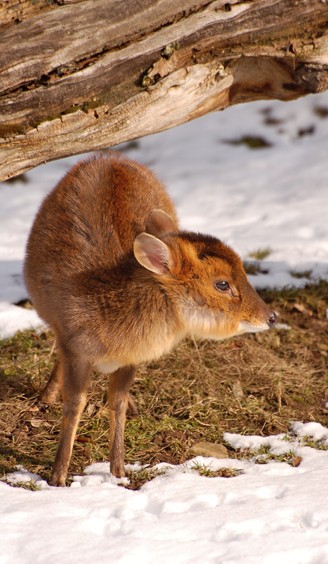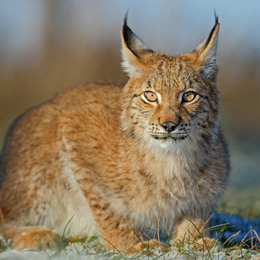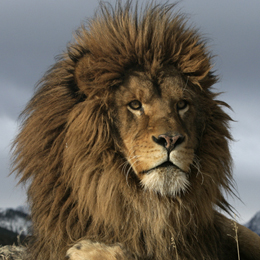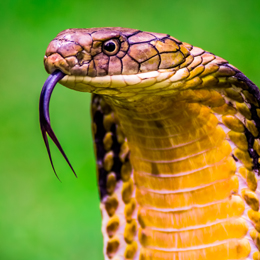Description
Muntjac deer, also called the mastreani deer, is a group of small deer found mainly in Southern Asia. The name Muntjac originates from the Sudanese “mencek”, which means small deer. Muntjac deer is also widely known as the barking deer, due its unique cry that resembles the bark of a dog. This group of deer consists of 12 known species and several subspecies, with unique features like small antlers and canine tusks.
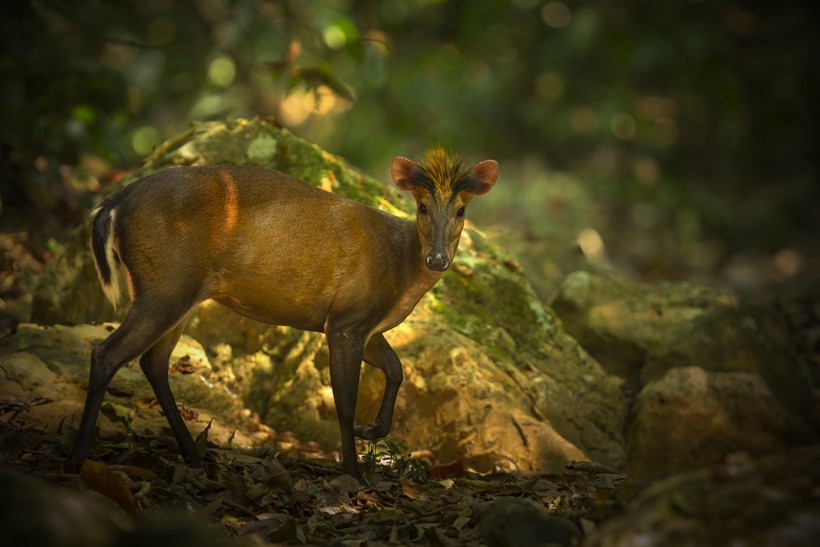
Fea's muntjac in the jungle of Thailand
?
Image credits: Sainam51/Shutterstock
It is quite easy to distinguish between males, females, adults and young ones of the genus Muntiacus. Male muntjac deer are larger and muscular than the female muntjacs. They have small and straight antlers that can grow up to 10 to 15 centimetres in size. The muntjac antlers re-grow after they are shed yearly during May and June. The new antlers are grown out completely between August and September. Females don’t have antlers; instead, they have a patch of fur on top of the bony knobs on their head.
The canines are longer and clearly visible in males, while, in females, the canines are small and mostly covered by their upper lip. The young ones grow quickly and can reach the size of an adult in just one year, but the adults have more muscular and sturdier bodies.
Like all deer species, muntjacs have eyes placed on the sides of its skull, giving them a wide range of vision to spot predators. It also relies on its sense of smell to spot predators or to find females. Along with all the basic senses, the deer also uses a special sixth sense, known as the vomeronasal organ. It is located in the upper side of the deer’s mouth. This organ is used to detect chemical scents left by other animals. The muntjac especially uses this organ to find females in oestrus. The muntjac deer buck lifts up its upper lip and allows air into its mouth, in order to sense chemical scents left by female muntjacs. A wild muntjac deer is estimated to survive for up to 10-15 years in its habitat while individuals in captivity have been recorded to live for up to 20 years.
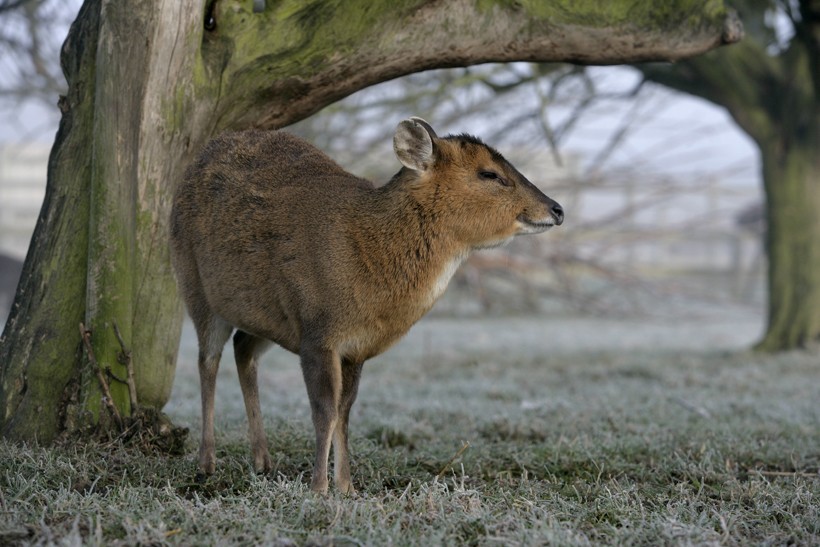
Wild encounters are extremely rare due to its shy nature
?
Image credits: Erni/Shutterstock
Muntjacs are small deer, with sizes ranging between 45 to 70 cm amongst different species. The giant muntjac is the largest of all muntjacs and an adult can weigh up to 60 Kg. However, on average, a muntjac deer weights anywhere between 10 to 20 kg.
Species and Distribution
There are 12 known species of muntjac deer. They are Indian-, Black-, Bornean yellow-, Gongshan-, Roosevelt’s-, Reeves’-, Fea’s-, Giant-, Truong Son-, Leaf-, Pu Hoat- and Sumatran muntjac.
Below the basic different features of all species are described including where they can be found and its conservation status.
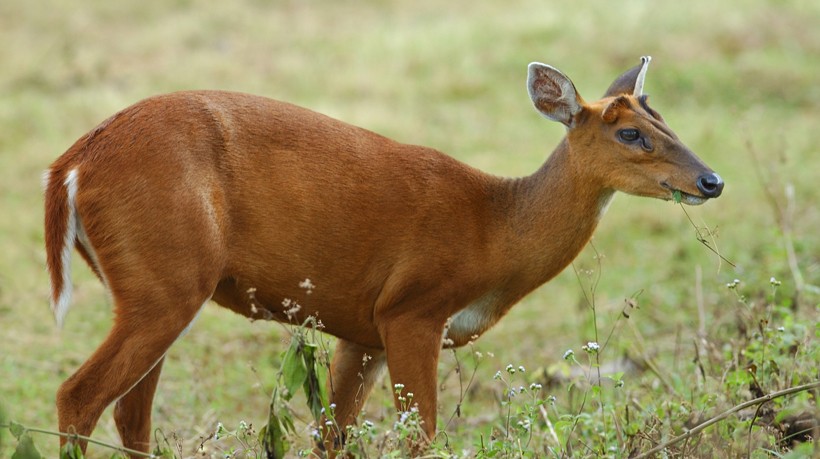
Female indian muntjac
?
Image credits: Hugh Lansdown/Shutterstock
- Indian Muntjac (Muntiacus muntjac)
The Indian Muntjac is found in Southern Asian regions of India, Nepal and Pakistan. It is also commonly known as the red muntjac due to the rusty colour of its coat. The population of this species is of least concern to the IUCN, as they flourish in numbers in their habitat.
- Black Muntjac (Muntiacus crinifrons)
The black muntjac is widely known as the hairy-fronted muntjac and also as the red-headed blue muntjac. The species gets its name due to its dark colour and unique red hair on top of its head, between the ears. The black muntjac can also be identified by its long tail with white hair on both sides. This species of muntjac deer is considered vulnerable and highly endangered with only a few thousand individuals remaining in the wild. The main threats are habitat loss due to human occupation and hunting. Due to loss of habitat, the black muntjac is restricted to eastern China, western Zhejiang, North-eastern Jiangxi and northern Fujian. Even though the population is seriously vulnerable to the threat of extinction, there are no active conservation measures being carried out in its range.
- Bornean Yellow Muntjac (Muntiacus atherodes)
The Bornean Yellow Muntjac gets its name due to its yellow-orange fur. It is found on the Bornean Island and in parts of Indonesia and Malaysia. This species is of least concern to the IUCN, as they flourish in their range. However, human activity in its habitat is causing dropping numbers. Biologists estimate that the species can be listed soon as under threat for this reason.
- Gongshan Muntjac (Muntiacus gongshanensis)
The Gongshan Muntjac gets its name due to its range of habitat, the Gongshan Mountains. It is found in north-western Yunnan, Tibet and northern Myanmar. It was long believed that the hairy muntjac found in the north-eastern India was the black muntjac. However, extensive genetic studies, later on, revealed that they are Gongshan muntjac. Studies are ongoing and the species found in Arunachal Pradesh is yet to be understood completely.
- Roosevelt’s Muntjac (Muntiacus rooseveltorum)
The Roosevelt’s barking deer was discovered in 1929 in an expedition conducted by Theodore Roosevelt Junior and Kermit Roosevelt. This species of muntjac was under dispute due to its resemblance with two other species in its range. However, it is smaller than the common muntjacs. It was proposed that the Roosevelt’s muntjac is actually a subspecies until 1999 when extensive genetic studies proved that it is a species on its own. Due to the late discovery of this species, its population status and habitat range are still being studied by biologists. IUCN listed this species as “data deficient” for the time being.
The Indian Muntjac is found in Southern Asian regions of India, Nepal and Pakistan. It is also commonly known as the red muntjac due to the rusty colour of its coat. The population of this species is of least concern to the IUCN, as they flourish in numbers in their habitat.
The black muntjac is widely known as the hairy-fronted muntjac and also as the red-headed blue muntjac. The species gets its name due to its dark colour and unique red hair on top of its head, between the ears. The black muntjac can also be identified by its long tail with white hair on both sides. This species of muntjac deer is considered vulnerable and highly endangered with only a few thousand individuals remaining in the wild. The main threats are habitat loss due to human occupation and hunting. Due to loss of habitat, the black muntjac is restricted to eastern China, western Zhejiang, North-eastern Jiangxi and northern Fujian. Even though the population is seriously vulnerable to the threat of extinction, there are no active conservation measures being carried out in its range.
The Bornean Yellow Muntjac gets its name due to its yellow-orange fur. It is found on the Bornean Island and in parts of Indonesia and Malaysia. This species is of least concern to the IUCN, as they flourish in their range. However, human activity in its habitat is causing dropping numbers. Biologists estimate that the species can be listed soon as under threat for this reason.
The Gongshan Muntjac gets its name due to its range of habitat, the Gongshan Mountains. It is found in north-western Yunnan, Tibet and northern Myanmar. It was long believed that the hairy muntjac found in the north-eastern India was the black muntjac. However, extensive genetic studies, later on, revealed that they are Gongshan muntjac. Studies are ongoing and the species found in Arunachal Pradesh is yet to be understood completely.
The Roosevelt’s barking deer was discovered in 1929 in an expedition conducted by Theodore Roosevelt Junior and Kermit Roosevelt. This species of muntjac was under dispute due to its resemblance with two other species in its range. However, it is smaller than the common muntjacs. It was proposed that the Roosevelt’s muntjac is actually a subspecies until 1999 when extensive genetic studies proved that it is a species on its own. Due to the late discovery of this species, its population status and habitat range are still being studied by biologists. IUCN listed this species as “data deficient” for the time being.
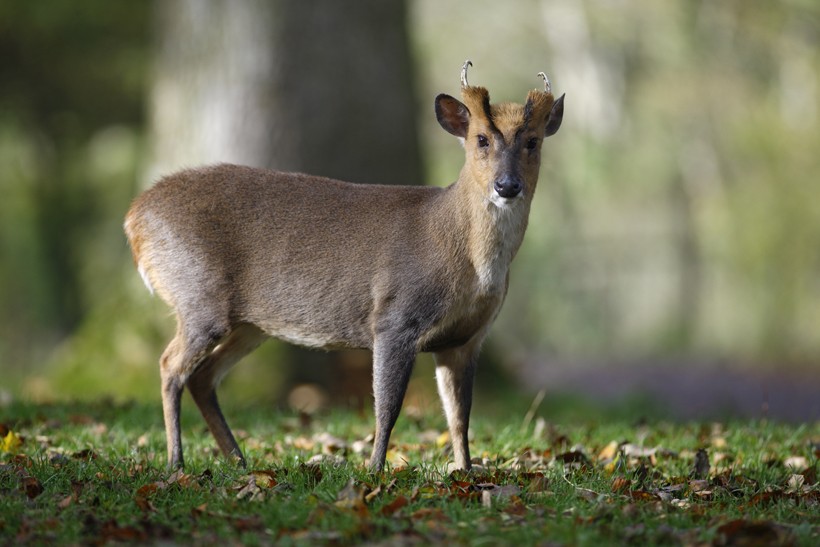
Reeves' Muntjac or Chinese muntjac
?
Image credits: Erni/Shutterstock
- Reeves’ Muntjac (Muntiacus reevesi)
Reeves’ Muntjac, or Chinese muntjac is native to Southern China and Taiwan. They are named after John Reeves, a British inspector from the East India Tea Company. The species was introduced in various parks in England in early 20th century. From that time muntjacs in England have, since escaped, spread widely in woodlands of the country. As they breed throughout the year, their numbers have increased largely. IUCN listed this species as of “least concern”, due to their capability to reproduce and flourish rapidly.
Reeves’ Muntjac, or Chinese muntjac is native to Southern China and Taiwan. They are named after John Reeves, a British inspector from the East India Tea Company. The species was introduced in various parks in England in early 20th century. From that time muntjacs in England have, since escaped, spread widely in woodlands of the country. As they breed throughout the year, their numbers have increased largely. IUCN listed this species as of “least concern”, due to their capability to reproduce and flourish rapidly.
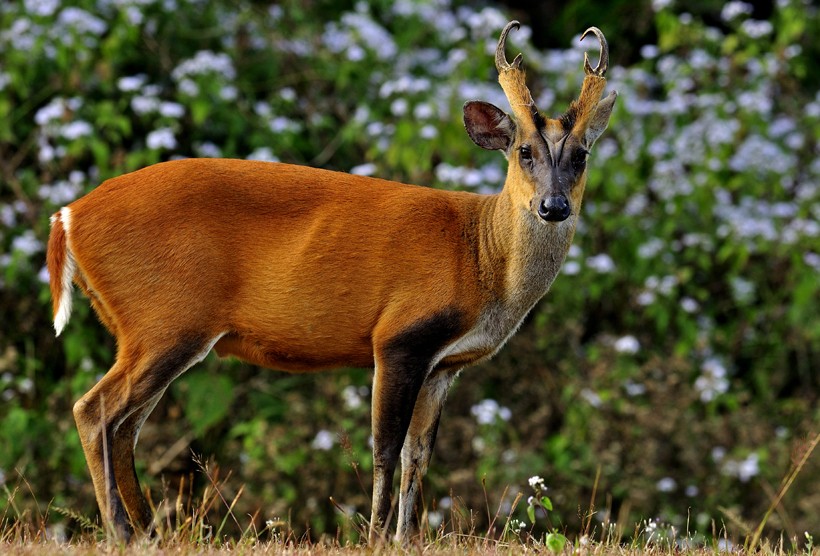
Fea's Muntjac
?
Image credits: Super Prin/Shutterstock
- Fea’s Muntjac (Muntiacus feae)
This species is named after zoologist Leonardo Fea who spotted this species first. The Fea’s Muntjac is also widely known as Tenasserim muntjac. It is native to Thailand and parts of Myanmar. It is quite similar in size to the common Indian muntjac but has a slightly darker coat. The population of Fea’s muntjac is under study. Especially due to the shy behavior and montane habitat of this species, very few is known about its range and distribution. The IUCN listed this species as “data deficient” and demands more information and research concerning this species.
- Giant Muntjac (Muntiacus vuquangensis)
The Giant Muntjac is the largest species in the genus Muntiacus. It is found in the Annamite mountain range, also known as the Truong Son mountain chain, situated in Vietnam. It is twice as large as the common muntjac, capable of reaching a shoulder height of up to 70 cm. A fully grown adult can weigh up to 60 kg. This species was only discovered in the 90’s last century and has been under study since then. Their population is listed as “endangered”, by the IUCN. Hunting and loss of habitat are the major threats for this creature. It has a very small global range of habitat. Only little is known about its habitat preferences and distribution, which makes it extremely difficult for researchers to carry out effective conservation measures.
- Truong Son Muntjac (Muntiacus truongsonensis)
The Truong Son Muntjac is also known as Annamite muntjac, because it lives in the Annamite mountain range. Opposite to its neighbour, the giant muntjac, the Annamite muntjac is one of the smallest of all muntjac species. An adult Annamite muntjac weights only between 11-15 kg. Due to its small size, it is also widely known as pygmy muntjacs or pygmy deer.
- Leaf Muntjac (Muntiacus putaoensis)
The leaf muntjac is another small species of muntjac found in north-eastern Putao, Myanmar. It is also known as Putao muntjac or simply, leaf deer. It was discovered only in the late 90’s last century and hence, very little is known about this animal. Unlike other muntjacs, both males and females of this species have long visible canines, and the fawns bear no spots at all. They stand around 50 cm tall at shoulder height and adults weight up to 11 kilograms.
- Pu Hoat Muntjac (Muntiacus puhoatensis)
The Pu Hoat Muntjac was discovered in 1997 in the Pu Hoat region of Vietnam. Since then, the species has been under study by biologists. The small deer is extremely hard to spot in the wild. Due to this, very little is known about the species and its population status. DNA studies show that it is closely related to M. Rooseveltorum and M. Truongsonensis, indicating that the Pu Hoat muntjac may be actually a subspecies of any one of the mentioned two species of muntjacs. Pu Hoat muntjac is temporarily listed as a different species, as long as strong evidence of its relativeness to the other two species is not obtained.
- Sumatran Muntjac (Muntiacus Montanus)
Bones of the Sumatran muntjac was discovered in 1914 in Sumatra. The bone specimens looked different than any known species of muntjac. However, a living Sumatran muntjac was not spotted until the 1930’s. It is sometimes referred to as a subspecies of the common muntjac or Muntiacus muntjac found in India. Due to lack of information, there are numerous taxonomical disputes and contradictions on the Sumatran muntjac. IUCN listed the situation as “data deficient”.
Note: The entire muntjac deer tribe is one of the oldest known animals, with fossils that date back several million years ago. However, wild encounters are extremely rare due to its shy nature. The above-mentioned species are well-known to researchers, but there are ongoing studies that may change their taxonomy in future. As there are many species and subspecies of muntjacs in Asia, only thorough examination can determine their correct taxonomic status.
This species is named after zoologist Leonardo Fea who spotted this species first. The Fea’s Muntjac is also widely known as Tenasserim muntjac. It is native to Thailand and parts of Myanmar. It is quite similar in size to the common Indian muntjac but has a slightly darker coat. The population of Fea’s muntjac is under study. Especially due to the shy behavior and montane habitat of this species, very few is known about its range and distribution. The IUCN listed this species as “data deficient” and demands more information and research concerning this species.
The Giant Muntjac is the largest species in the genus Muntiacus. It is found in the Annamite mountain range, also known as the Truong Son mountain chain, situated in Vietnam. It is twice as large as the common muntjac, capable of reaching a shoulder height of up to 70 cm. A fully grown adult can weigh up to 60 kg. This species was only discovered in the 90’s last century and has been under study since then. Their population is listed as “endangered”, by the IUCN. Hunting and loss of habitat are the major threats for this creature. It has a very small global range of habitat. Only little is known about its habitat preferences and distribution, which makes it extremely difficult for researchers to carry out effective conservation measures.
The Truong Son Muntjac is also known as Annamite muntjac, because it lives in the Annamite mountain range. Opposite to its neighbour, the giant muntjac, the Annamite muntjac is one of the smallest of all muntjac species. An adult Annamite muntjac weights only between 11-15 kg. Due to its small size, it is also widely known as pygmy muntjacs or pygmy deer.
The leaf muntjac is another small species of muntjac found in north-eastern Putao, Myanmar. It is also known as Putao muntjac or simply, leaf deer. It was discovered only in the late 90’s last century and hence, very little is known about this animal. Unlike other muntjacs, both males and females of this species have long visible canines, and the fawns bear no spots at all. They stand around 50 cm tall at shoulder height and adults weight up to 11 kilograms.
The Pu Hoat Muntjac was discovered in 1997 in the Pu Hoat region of Vietnam. Since then, the species has been under study by biologists. The small deer is extremely hard to spot in the wild. Due to this, very little is known about the species and its population status. DNA studies show that it is closely related to M. Rooseveltorum and M. Truongsonensis, indicating that the Pu Hoat muntjac may be actually a subspecies of any one of the mentioned two species of muntjacs. Pu Hoat muntjac is temporarily listed as a different species, as long as strong evidence of its relativeness to the other two species is not obtained.
Bones of the Sumatran muntjac was discovered in 1914 in Sumatra. The bone specimens looked different than any known species of muntjac. However, a living Sumatran muntjac was not spotted until the 1930’s. It is sometimes referred to as a subspecies of the common muntjac or Muntiacus muntjac found in India. Due to lack of information, there are numerous taxonomical disputes and contradictions on the Sumatran muntjac. IUCN listed the situation as “data deficient”.
Habitat
Muntjac deer prefer temperate deciduous forests, scrublands and woodlands. They like to be in a habitat with lush vegetation close to the ground. These deer are strictly herbivorous and can be seen munching on tender leaves, fruits or grass, whenever they are active.
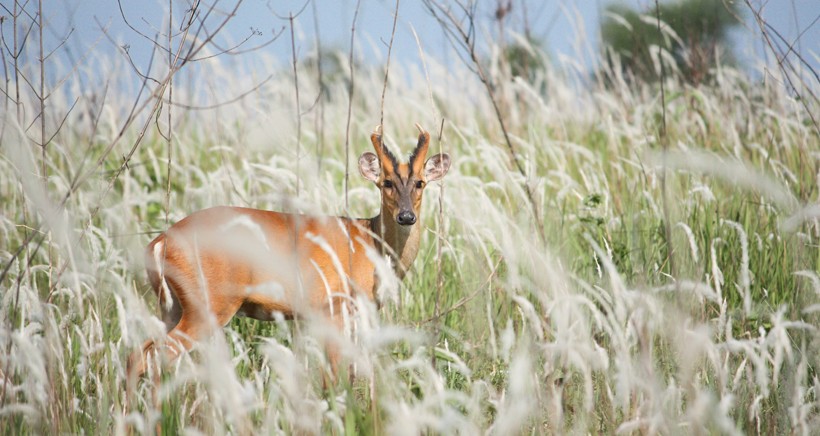
Muntjac deers like to be in a habitat with lush vegatation close to the ground
?
Image credits: Thousandlies/Shutterstock
They prefer woodlands that are close to water sources. Some species of muntjacs are capable of flourishing even under unfavourable conditions, especially due to their adaptations to handle or survive their habitat. They can reproduce any time of the year and quickly increase their numbers. The group can adversely affect the habitat by overgrazing if the habitat lacks predators of the deer.
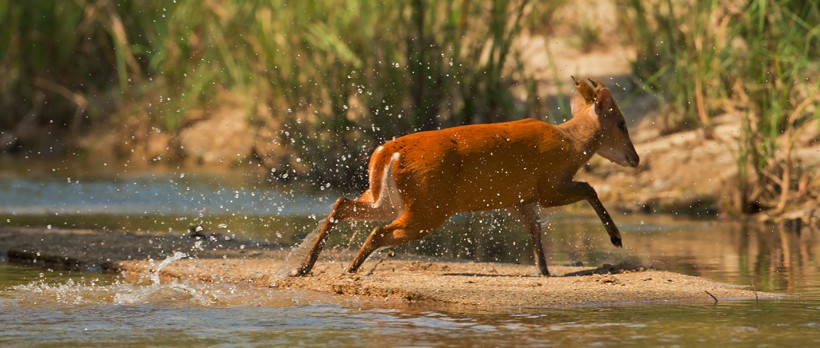
Muntjac deer crossing water
?
Image credits: Sainam51/Shutterstock
When it comes to predators, muntjacs are facing many of the toughest predators on the planet. In its range in Asia, the muntjac habitat consists of top predators like tigers, leopards (snow leopard, clouded leopard), wolves, jackals, crocodiles and large pythons.
These apex predators have sharp senses and unmatched strength, enabling them easily to hunt small deer like the muntjacs. However, the muntjacs’ small size helps them to stay hidden in the low-lying bushes to evade predators.
Reproduction and Lifecycle
The muntjac deer doesn’t follow any specific breeding season. They can breed round the year; females give birth to a single fawn, occasionally twins. Females reach sexual maturity earlier than the males, at an age of 7 to 9 months, while males can become sexually mature between 11 to 12 months after birth.
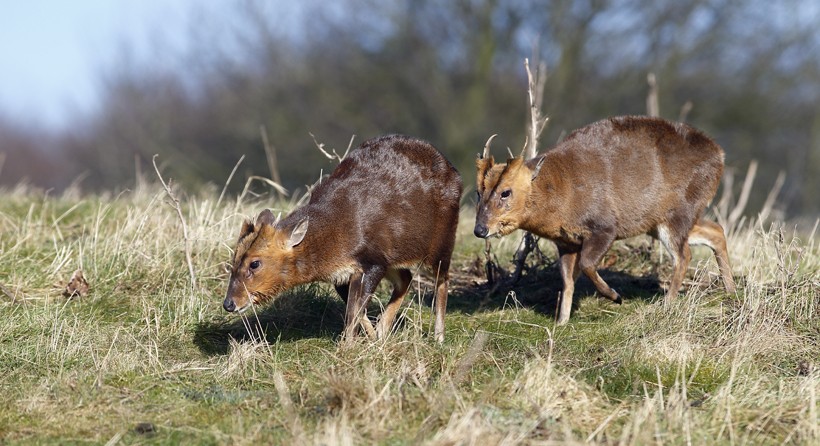
Young ones can reach the size of an adult in just one year
?
Image credits: Erni/Shutterstock
Throughout the year, males search for females in their territory and try to mate with them. The gestation period lasts for up to 230 days or approximately 7-8 months. The fawn is small and has visible spots on its coat. Females stop lactation, once the fawn is 7-8 weeks old. Fawns have a good survival ratio, helping the species to flourish in numbers. Under favourable conditions, a muntjac deer can live for up to 15-20 years. The female is capable of breeding again within a few days after giving birth, which means, a doe can give birth to a new fawn every 7 months.
Behavior and Communication
Their nature of interaction with the habitat is yet not fully understood. Wild muntjacs are spotted active during the day as well as during the night. However, individuals in captivity tend to show a crepuscular behavior. Muntjac deer are solitary grazers that occasionally form small herds of 4-5 individuals. They patrol their territory, in search for food and mates. Females are often seen with a fawn, and their territory overlaps with several other territories of surrounding males. Males are not very aggressive, but they like to keep separate territories. They usually tolerate other muntjacs, but fights can occur when a female is at stake. Male muntjacs fight with their antlers and can cause serious injuries to each other. They also make use of their long canines, which can tear flesh like a dagger.
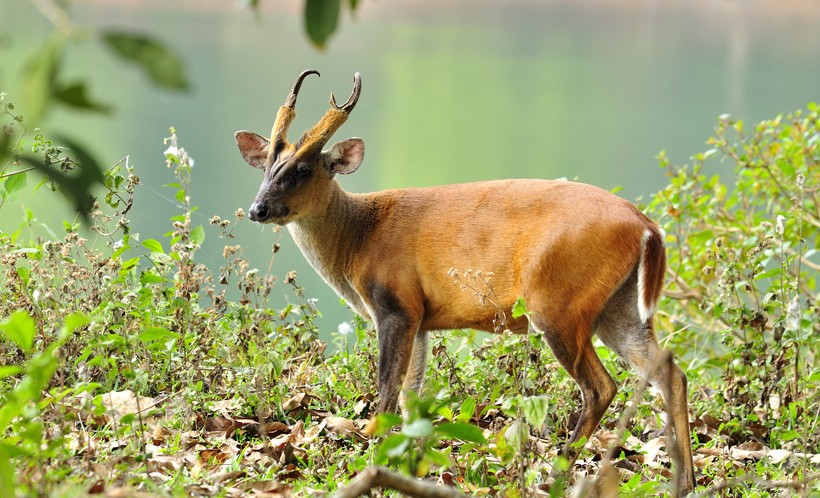
Muntjac/Barking deer at a lake
?
Image credits: Super Prin/Shutterstock
The barking sound of a muntjac deer is an alarm call to alert nearby muntjacs about a potential threat. The muntjac deer call can be heard regularly at dawn and dusk, indicating that it can be a mode of communication as well. The bark is very similar to the sound of a groaning dog or a fox. Fawns and females squeal for their communication with each other. The muntjac is not a very smart creature but, assisted by its senses and survival skills, it is well capable of flourishing in its habitat.
Population and conservation
Muntjac deer are found in Southern Asia and parts of China; some species have been introduced in the United Kingdom as well. Collectively, the barking deer tribe is flourishing due to their rapid reproduction rate. They can reproduce any time of the year and are capable of raising their numbers quickly. However, when each species is taken into account individually, only a few are actually seen flourishing. Species like the giant and black muntjac are under threat due to loss of habitat, predation and hunting. Due to their rapid reproduction rate, they often come in conflict with the local population.
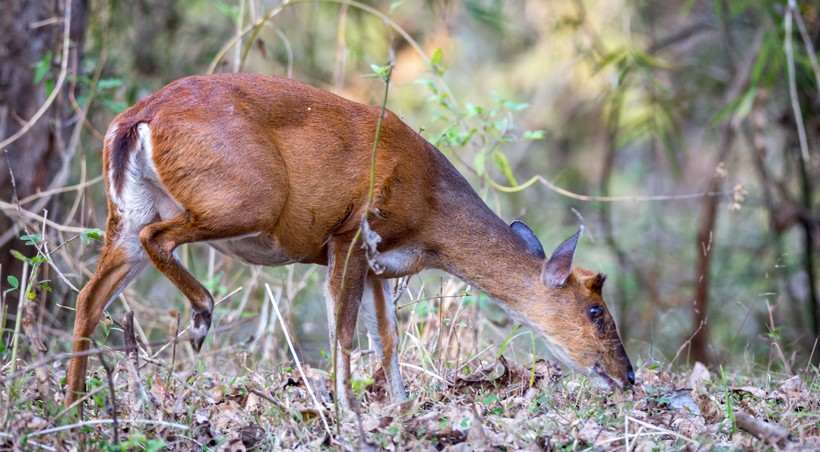
As result of the habitat loss, muntjacs raid farmers' fields
?
Image credits: Girish HC/Shutterstock
Muntjacs can raid fields and cause severe damage to farmers’ crops. As a result, these deer are often received with hate at places where human activity is nearby their habitat. Road traffic is also one of the major killers for muntjacs. With an increasing number of vehicles, many road kills occur when the deer tries to cross the road in search of food.
Due to lack of information about their particular habits, it appeared extremely difficult for researchers to implement appropriate conservation measures.
Evolution
The muntjac deer is the oldest known member of the deer family. Fossil records indicate that the species must have come into existence over 30 million years ago. Very little is known about the ancestry of muntjacs. The earliest known deer-like creature is Protoceras. Protoceras did not have antlers but had horns and their physical structure was very similar to modern deer. Muntjacs are one of the earliest known deer species that bear antlers.
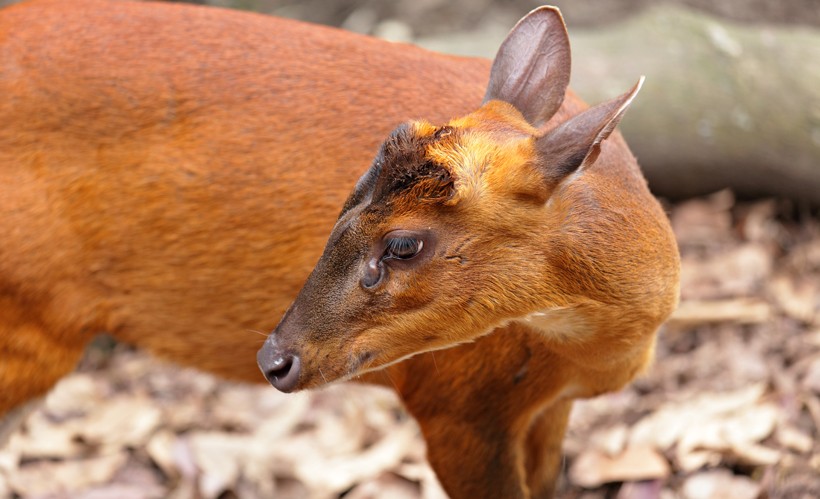
The Indian muntjac (image) and Fea’s muntjac share a common ancestor
?
Image credits: leungchopan/Shutterstock
Dicrocerus Elegans is the oldest known deer that could shed antlers like muntjacs. Fossils of Dicrocerus Elegans indicate that the animal roamed on earth over 25 million years ago. It is thus speculated that small deer like the muntjacs or tufted deer must have evolved from the Dicrocerus Elegans. Other fossils also indicate that the deer species experienced a split approximately 7 to 10 million years ago; the Cervinae split from Muntiacinae. Cervinae went through many physical changes over the course of time while the Muntiacinae remained unchanged. Muntjacs of the Miocene era were smaller than modern muntjacs. Molecular data reveal that the common Indian muntjac and Fea’s muntjac share a common ancestor while the giant muntjacs are quite distinct. Giant muntjacs are closer to Reeves’ Muntjac, than any other species of muntjac deer. Evolution of the muntjacs is still being studied and new discoveries are being made. Hence, the exact story of its evolutionary history is not yet written today.
Funfacts
- Though muntjac deer is one of the oldest known species of deer, it is also one of least studied species.
- Muntjacs are one of the smallest species of deer on the planet.
- They can reproduce any time of the year.
- Females can mate in a few days after giving birth.
- Muntjacs shed their antlers every year.
- Muntjac deer is producing a unique cry that resembles the bark of a dog
- Its bark is often misunderstood by locals. The groaning sound gives rise to many paranormal stories around the region.
- Though herbivorous in nature, their long canine teeth may cause serious damage in case of fighting.
- On average, muntjacs weight only around 10 to 20 kilograms.
- Though they are hunted by top predators like tigers, crocs, pythons, leopards and humans, muntjacs have survived for over 25 million years on our planet.
